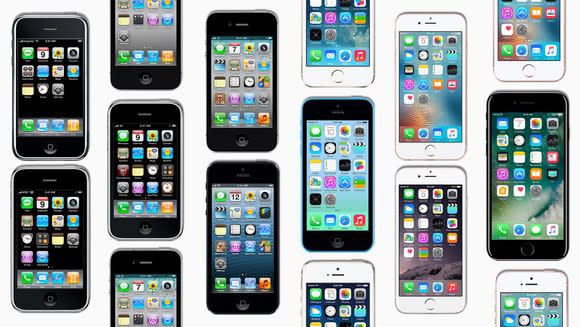3 Things to Expect From Apple Inc.'s 2019 iPhones
In the fall of 2019, Apple (NASDAQ: AAPL) will undoubtedly release a set of new flagship smartphones with significant feature enhancements over the models that'll make it to market about six months from now.
We don't know all of the key specifications and selling points of the 2018 iPhone models, though I expect that they'll be reported fairly soon. Still, there are things that can be predicted with a reasonable degree of confidence, even at this early stage, about Apple's 2019 iPhone lineup. Here are three.

Image source: Apple.
1. Huge jump in cellular performance
Over the next two iPhone generations, investors and consumes alike should expect Apple to deliver large improvements in the cellular capabilities of its devices.
The 2018 iPhone models are expected to come with modems that support gigabit LTE capability, which translates into a roughly 67% increase in peak theoretical download speeds over the iPhone models released in 2017.

Image source: Apple.
It's a virtual certainty that the 2019 iPhone models will use Intel's (NASDAQ: INTC) XMM 7660 LTE modem, as Intel has supplied LTE modems to Apple for two generations now and is believed to be the sole supplier of LTE modems in the 2018 iPhone models.
According to Intel, the XMM 7660 supports peak download speeds of 1.6 gigabits per second, which translates into a 60% boost in peak theoretical download speeds compared with what the XMM 7560 that'll probably power the 2018 iPhone models is capable of.
In the real world, it's not clear if the modem upgrades will have a noticeable impact, but the big boost in cellular speeds could, at a minimum, be an effective marketing point.
2. Rear-facing TrueDepth camera
Apple's current flagship, the iPhone X, has a front-facing camera with depth-sensing capabilities that the company markets as a "TrueDepth" camera system. According to a recent report from Bloomberg, Apple is working on adding depth-sensing capabilities to the rear-facing cameras of the 2019 iPhone models. This, Bloomberg, says, would represent "another step toward turning the [iPhone] into a leading augmented-reality device."
Such a feature could prove to be a compelling selling point for the 2019 iPhones, especially if Apple could demonstrate use cases for the feature that go beyond the gimmicky, as many of the uses for the current TrueDepth camera are.
3. Significant display enhancements
Over the last several iPhone generations, Apple has added interesting new features to the displays of the devices. With the iPhone 6 and 6 Plus, Apple moved to new liquid crystal displays that delivered improved contrast and viewing angles over the displays in the iPhone 5 and 5s.
With the iPhone 6s and 6s Plus, Apple added 3D Touch capability, which allowed the displays on those devices to detect the amount of force a user applied to the screen. Then, in the iPhone 7 series of devices, Apple dramatically improved the brightness and color accuracy of the displays and endowed them with the ability to show a much wider range of colors.
With the iPhone 8 series of devices, Apple added True Tone capability, which allowed displays to change color temperature in response to the surrounding lighting, improving perceived image quality. Alongside the iPhone 8 series, Apple introduced the iPhone X, which included an entirely new organic light emitting diode display.
I think that over the next two years, Apple will introduce the following display enhancements to its flagship iPhone models: higher refresh rates and higher brightness.
My guess is that one of those enhancements will make it to the 2018 iPhone X-series iPhones, and the other will make it into the 2019 iPhone models. If Apple is really ambitious, we could see brighter and faster displays in the 2018 iPhone models and then additional changes, such as screen size increases and curved edges, in the 2019 models.
At any rate, I think the flagship iPhones that launch in 2019 will include displays that make the one on the iPhone X -- a display that's been widely praised -- seem dated.
More From The Motley Fool
Ashraf Eassa owns shares of Intel. The Motley Fool owns shares of and recommends Apple. The Motley Fool has the following options: long January 2020 $150 calls on Apple and short January 2020 $155 calls on Apple. The Motley Fool recommends Intel. The Motley Fool has a disclosure policy.
